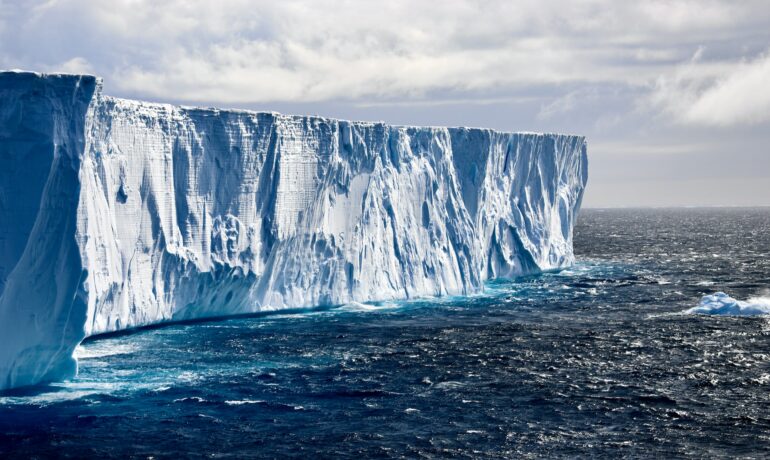Antarctic sea ice deeply affects the global climate in several ways. It regulates the exchanges of heat and gases between the ocean surface and the atmosphere, and drives the formation of the Antarctic Bottom Water that travels over global oceans.
Since continuous satellite records began in the 1980s, the evolution of Antarctic sea-ice has shown patterns of strong regional and seasonal variability, in contrast to a uniform and rapid loss of sea ice that characterized the Arctic domain. Indeed, the Antarctic sea-ice has undergone rapid swings in its net hemispheric coverage since 2012, to first record high (2013-2015) then record low (2016-2022) coverage.
While the sea-ice coverage has expanded over most of the Antarctic Ocean with large interannual variability, some areas such as the eastern Ross Sea to the Antarctic Peninsula have experienced significant sea ice loss. The sum of the different regional contributions is an overall slightly increasing trend of sea-ice coverage over the past few decades.
Several factors, such as the atmospheric circulation changes linked to the stratospheric ozone depletion, the ocean warming and ice shelf melt, are reported to explain the decadal sea ice variability in the Antarctic Seas. As suggested by previous studies, slow and long-term processes that influence the decadal ice variability, also contribute to the sea ice increase.
However, there is still substantial uncertainty in current model estimates and accurate prediction of the decadal sea ice variability in the Antarctic Seas remains challenging for the climate modeling community.
Thanks to the collaboration with Yushi Morioka, an ocean and climate researcher at Japan Agency for Marine-Earth Science and Technology (JAMSTEC), CMCC researchers Dorotea Iovino, Andrea Cipollone and Simona Masina from the Division on Ocean modeling and Data Assimilation (ODA) demonstrated that variability of sea ice in the west Antarctic seas can be predicted over decadal time scales with significant skills using a coupled atmosphere-ocean-sea ice circulation model in which both ocean and ice properties are initialized with the observation-based datasets. This approach allows skillful prediction of the year-to-year sea ice variability up to 6 years.
“Using an ensemble of decadal reforecast experiments, we found that prediction skill of sea ice variability crucially depends on a realistic initial representation, not only of sea ice but also of subsurface temperature and salinity fields” explains Dorotea Iovino.
“Data about the ocean, and especially about its subsurface temperature and salinity, have demonstrated to be a great added value. If the coupled predictive system can rely on a description of both the ocean and sea ice conditions, then the prediction skills of decadal sea ice variability are significantly improved, in particular in the west Antarctic region.”
A figure from the paper published in Communications Earth & Environment compares the prediction skill-scores of a set of numerical experiments with different initial conditions: the first experiment is the control (a, CTL) experiment in which the sea surface temperature is initialized with an observed field; the second experiment is the sea ice restoring (b, SIR) experiment in which the surface temperature and sea ice concentration are initialized with observations; in the third simulation (c, 3DVAR) the initial state of subsurface ocean temperature and salinity is included via a three-dimensional variational data assimilation approach.
In the latest and newest approach (3DVAR), the climate model is able to better capture the sea ice increase after the late 2000s and provides the highest prediction skills of the sea ice concentration in the west Antarctica (Amundsen–Bellingshausen Seas). This significant improvement arises from a better representation of the subsurface ocean circulation and in particular the Antarctic Circumpolar Current and its variability on decadal time scales.
As expected, the beneficial effect of subsurface ocean initialization on the sea ice prediction skills is reduced in regions where the availability of observations is poor, as in the northern Weddell Sea, leading to an inaccurate initial state of ocean properties in the model experiments. Therefore, in these regions, the initialization of the sea ice concentration remains the most effective for skillful prediction of the decadal sea ice variability.
The decadal prediction of Antarctic Sea ice might be further improved by also taking into account the initial value of sea ice thickness estimates from satellite observations (mainly during austral winter). Further research along this line is now underway at CMCC.
More information:
Yushi Morioka et al, Decadal Sea Ice Prediction in the West Antarctic Seas with Ocean and Sea Ice Initializations, Communications Earth & Environment (2022). DOI: 10.1038/s43247-022-00529-z
Provided by
CMCC Foundation – Euro-Mediterranean Center on Climate Change
Citation:
Antarctic ice: A better knowledge of the ocean improves the predictability of sea ice variability (2022, December 5)



